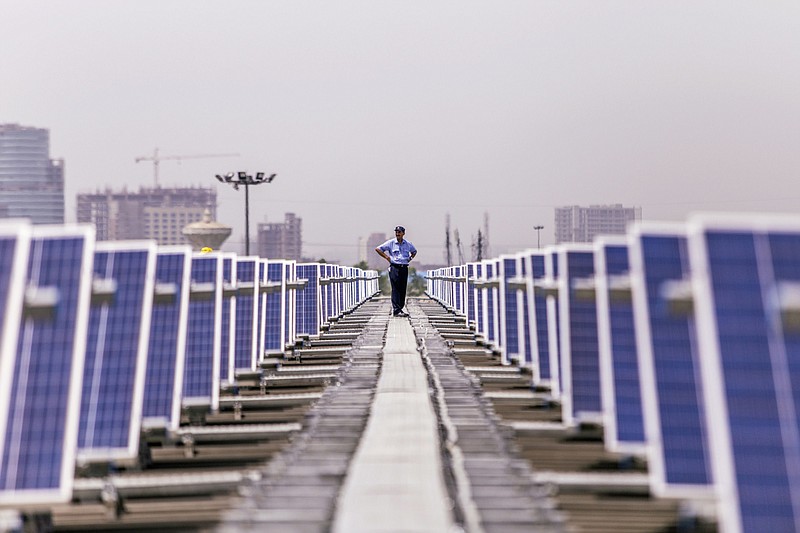A key selling point that made solar energy the fastest-growing power source in the world -- rapidly decreasing costs -- has hit a speed bump.
Solar module prices have risen 18% since the start of the year after falling by 90% over the previous decade. The reversal, fueled by a quadrupling in the cost of the key raw material polysilicon, threatens to delay projects and slow uptake of solar power just as several major governments are finally throwing their weight behind it in an effort to slow climate change.
"The disruption to solar hasn't been this bad in more than a decade," said Jenny Chase, lead solar analyst with clean-energy research group BloombergNEF. "Developers and governments are going to have to stop expecting solar to get much cheaper quickly." BloombergNEF slightly lowered its forecast for solar build-out this year in a report last week, citing rising prices of materials, including polysilicon, as one reason.
Polysilicon is an ultra-refined form of silicon, one of the most abundant materials on Earth that's commonly found in beach sand.
As the solar industry geared up to meet an expected surge in demand for modules, makers of polysilicon were unable to keep up. Prices for the purified metalloid have touched $25.88 a kilogram, from $6.19 less than a year ago, according to PVInsights.
For the solar industry, the timing couldn't be worse. Renewable energy finally has a champion in the White House and ambitious climate goals have been announced across Europe and Asia.
But in addition the new financial hurdle, the Biden administration's solar power ambitions are colliding with complaints that most of the global supply of polysilicon might be produced by forced labor in China.
The global industry gets 45% of its supply from Xinjiang, the northwestern region where the ruling Communist Party is accused of mass incarceration of minority groups and other abuses. Other parts of China supply 35%. Only 20% comes from U.S. and other producers.
In Xinjiang, more than 1 million Uyghurs and other members of predominantly Muslim ethnic groups have been forced into detention camps, according to foreign researchers and governments. Authorities are accused of forced sterilizations of members of minority groups and of destroying mosques.
Chinese officials reject accusations of abuse and say the camps are for job training aimed at economic development and deterring radicalism.
U.S. and some Chinese solar vendors have pledged to avoid suppliers that might use forced labor. It isn't clear, however, whether they can meet rising demand without Xinjiang, where Beijing won't allow independent inspections of workplaces.
Biden's climate envoy, John Kerry, says Washington is deciding whether to keep solar products from Xinjiang out of U.S. markets.
Meanwhile, polysilicon prices are expected to remain strong through the end of 2022, according to Roth Capital Partners analysts including Philip Shen.
And the problem isn't limited to polysilicon. The solar industry is facing "pervasive upstream supply-chain cost challenges," panel manufacturer Maxeon Solar Technologies said in April.
Solar panels are made from sand that's heated and purified to ingots of ultra-conductive polysilicon that are sliced into razor-thin wafers, wired up into cells and then assembled into the panels that are mounted rooftops and cover vast fields.
Prices for steel, aluminum and copper are also up, as are freight charges. Solar-microinverter supplier Enphase Energy said it expects its shipment volumes to be constrained by semiconductor-component availability.
"Downstream of polysilicon, it's very painful," Canadian Solar Vice President Xiong Haibo said at a conference in China, according to industry publication Solarbe. "At present, none of the downstream companies are profitable and all of them are reducing production."
Still, the reversal of the long-term downward trend in costs is partly offset by a continual improvement in the efficiency of solar panels, said Nitin Apte, chief executive officer of Vena Energy, a leading independent renewable power operator in Asia-Pacific. The company isn't planning any delays this year at its solar projects across Japan, Taiwan, Australia and India.
"I see this as a short term situation, and a few projects might see that eat into our contingencies," Nitin said in an interview at his office in Singapore. "We're not slowing down construction. We're locking down orders at the best prices we can get."
Longer-term, the shortages are spurring construction of new polysilicon factories, including an announcement this month of what would be the largest facility in the world in China.
"One would expect that any material that has the kind of growth that polysilicon has had will continue to have capacity injected into the system," Vena's Nitin said. "The challenge is timing that capacity perfectly to the growth."
Information for this article was contributed by Dan Murtaugh and Brian Eckhouse of Bloomberg News (WPNS) and by Joe McDonald of The Associated Press.
